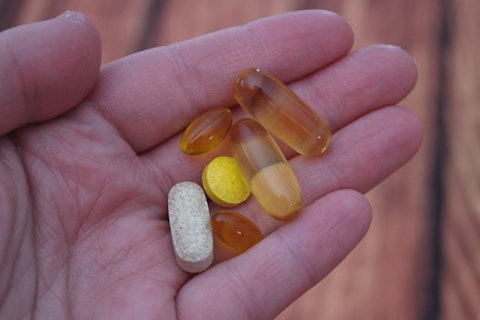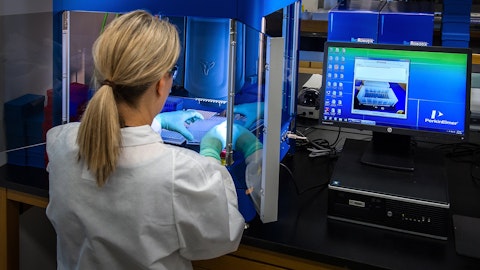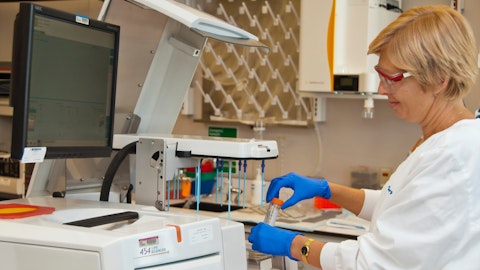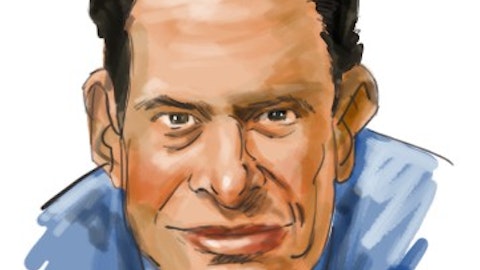BioCryst Pharmaceuticals, Inc. (NASDAQ:BCRX) Q4 2022 Earnings Call Transcript February 21, 2023
Operator: Good morning and welcome to the BioCryst Fourth Quarter 2022 Earnings Conference Call. Please note this event is being recorded. I would now like to turn the conference over to John Bluth at BioCryst. Please go ahead.
John Bluth: Thanks, Andrea. Good morning and welcome to BioCryst’s fourth quarter and year end 2022 corporate update and financial results conference call. Today’s press release and accompanying slides are available on our website. Participating with me today are CEO, Jon Stonehouse; CFO, Anthony Doyle; Chief Commercial Officer, Charlie Gayer; and Chief R&D Officer, Dr. Helen Thackray. Following our remarks, we will answer your questions. Before we begin, please note that today’s conference call will contain forward-looking statements, including those statements regarding future results, unaudited and forward-looking financial information as well as the company’s future performance and/or achievements. These statements are subject to known and unknown risks and uncertainties, which may cause our actual results, performance or achievements to be materially different from any future results or performance expressed or implied in this presentation.
You should not place undue reliance on these forward-looking statements. For additional information, including a detailed discussion of our risk factors, please refer to the company’s documents filed with the Securities and Exchange Commission, which can be accessed on our website. I’d now like to turn the call over to Jon Stonehouse.
Jon Stonehouse: Thanks, John. 2022 was another outstanding year for ORLADEYO as we doubled sales in our second full year of launch on top of the fantastic start we had in the first year. This shouldn’t be surprising given the excellent safety, efficacy and once-daily oral profile. We are consistently hearing from patients that ORLADEYO is changing their lives. As you will hear from Charlie, in the U.S., our prescriber base continues to grow both in breadth and depth. In addition, ORLADEYO is already commercially available to HAE patients in 15 countries around the world. The ability of ORLADEYO to deliver meaningful results for patients is driving the steady patient growth we are seeing quarter after quarter. And in 2023, we expect this strong steady demand to continue, leading to the global sales of no less than $320 million.
Our goal with this guidance is very simple to be accurate. Accurate guidance has been our track record since launch because we are the only ones with access to the prescription data through our sole source specialty pharmacy. With our sales performance in 2021 and 2022 and our guidance in 2023, you now have three data points to get a sense of the slope of the ORLADEYO launch. We are on a trajectory to achieve peak global sales of $1 billion and our IP for ORLADEYO extends out to 2039. So we expect to be at peak sales for many, many years. While our revenues continue to grow, we expect our operating expenses to be flat year-over-year as we have made and will continue to make thoughtful capital allocation decisions on our pipeline investment.

Photo by Kayla Maurais on Unsplash
This reduction in net cash use has strengthened our financial position moved us closer to profitability. You will hear more detail on this from Anthony shortly. Now I will turn the call over to Charlie to review ORLADEYO performance in more detail.
Charlie Gayer: Thanks, Jon. The base of patients treated with ORLADEYO in the United States continued to grow as expected in the fourth quarter as new patient starts and patient retention remain consistent with the trends we have seen over the last 2 years. The prescriber base expanded strongly again and existing prescribers continue to add new prescriptions. New starts on ORLADEYO were also distributed evenly with just over 50% coming from the top tier of healthcare providers who treat half of all HAE patients. As we begin 2023, we have confidence that we will achieve no less than $320 million in global revenue this year. Our U.S. field team expansion is in place and patient growth trends are on track. Our European growth is also gaining momentum and we continue to lay the foundation for ORLADEYO expansion globally.
And this weekend, we will present more long-term clinical and real world evidence at the Quad AI meeting adding to the growing body of evidence showing how ORLADEYO can improve the lives of patients living with HAE. We have noted before that typical U.S. payer reauthorization dynamics for rare disease products like ORLADEYO will soften Q1 revenue growth as many patients shift temporarily to free product. What we are seeing so far this year tells us that ORLADEYO revenue is likely to be flat to slightly down compared to Q4 even as our patient base continues to grow. We ended 2022 with a total number of patients on ORLADEYO that we expected and the patient growth trends we see in the U.S. and around the world give us confidence not only in our 2023 trajectory, but also that ORLADEYO peak revenue will reach $1 billion.
Helen, I will turn the call over to you.
Helen Thackray: Thanks, Charlie. Today, I’d like to provide some additional updates on the next step for BCX10013, our potential once-daily Factor D inhibitor to complement data we shared last month, initial data from our Phase 1 single ascending dose and multiple ascending dose trials in healthy volunteers showed rapid, sustained and greater than life suppression of the alternative pathway of the complement system, 24 hours following a single 110 milligram dose and BCX10013 has the space that generally well tolerated at all dose study state in the clinic. These data provide early support for development of BCX10013 and believe this product has the potential to differentiate once-daily oral vaccine inhibitor for multiple . The next key step in clinical development is those ranges work in patients with the goal of confirming optimal dosing pivotal set.
Non-clinical program helps us to assess the safe dosing range we can evaluate in humans. Recently, in emerging dose-related observations early in an ongoing chronic non-clinical study which were not seen at the same time period in a separate already completed study. We need to understand the full picture of these differences as they complete the currently ongoing study. At the same time, as a result of these observations, the pace at which we can evaluate higher doses in human to assess efficacy will be slower and we expect the related delay in the timeline. So in order to grasp towards clinical dose selection, we will continue working to understand what we are seeing in the ongoing non-clinical program and we will keep you posted on our progress.
In addition, 10013 we are making progress with our research program to identify oral medicines directed at other targets across the classical selection of terminal pathways of the conference system, including C2, which is a critical upstream serine protease enzyme for activation of the classical pathway. As we reported in January, we have developed potent-selective molecule targeting to and these are currently in the stage. Our long-term goal is to bring multiple novel orally-delivered products forward to treat any . Now I’ll pass it to Anthony.
Anthony Doyle: Thanks, Helen. You can find our detailed fourth quarter and year end financials in today’s earnings press release and I’d like to call your attention to a few items. Total revenue for the year came in at $271 million, over $250 million of which came from ORLADEYO in just its second year since launch, more than doubling net revenue from the prior year. Revenue for the fourth quarter was $79.5 million, of which $70.7 million came from net sales of ORLADEYO, with the remainder coming from sales of RAPIVAB, including the fulfillment of the last of our contract equipment stockpile. Operating expenses, not including non-cash stock compensation for the quarter were $110.6 million. This puts full year OpEx at $374.6 million, the increase compared to prior guidance was driven by almost $10 million of accelerated costs related to closeout activities for the termination of 9930 and 9250 programs.
Cash at the end of the year was at $444 million. Earlier in the year, we provided guidance for 2023 ORLADEYO revenue of no less than $320 million. For OpEx, we expect 2023 to be flat to the prior year at around $375 million. We previously stated that 2023 R&D investment would be in line with prior year. We are now forecasting that R&D expenses will decrease year-over-year following the discontinuation of the 9930 and 9250 programs and the delay in the 10013 clinical program that Helen described. This will be offset by additional commercial investments that we are making both here in the U.S. and as we continue our international expansion. As our revenue and OpEx curves continue to converge, we expect net cash utilization in 2023 to decrease compared to 2022 even when factoring in the royalty curve.
The combination of our strong balance sheet, increasing revenue and our disciplined approach to capital allocation puts us in an outstanding financial position with an ever decreasing reliance on the capital markets. Now, operator, we will be happy to open up to Q&A.
See also 20 Largest Petrochemical Companies in the World and 12 Best Dividend Growth Stocks with 10+% Increases.
Q&A Session
Follow Biocryst Pharmaceuticals Inc (NASDAQ:BCRX)
Follow Biocryst Pharmaceuticals Inc (NASDAQ:BCRX)
Operator: And our first question comes from Jessica Fye of JPMorgan. Please go ahead.
Jessica Fye: Great. Good morning guys. Thanks for taking my questions. Two for me. I guess first, what else can you share with us about the dose-dependent finding with 10013? And second, maybe a nuance here, but if I recall at the healthcare conference, you indicated that 1Q revenue would be roughly flat with 4Q, I think now you are saying flat to slightly down. Does that just mean we should think of 4Q revenue as being even higher than it would have been otherwise or does that take a little bit of the buffer out of whatever might have been in your full year guidance? Thank you.
Jon Stonehouse: Helen, take the first one.
Helen Thackray: Yes. Sure. Good morning. So we in the non-clinical findings, what we are saying is that we are seeing something at a time point that is not at a time point in our other studies. And the impact then is that we want to learn more about the safe branch exposure and we understand the difference.
Anthony Doyle: And Jess, as far as the Q4 and Q1 revenue, so this is not a Q4 being bigger than it should be, it’s really based on what we’re seeing out there with Q1 reauthorization. It’s always a challenge every year. And what we are seeing is that this year, it’s just this isn’t an ORLADEYO specific thing just broadly the reauthorization process is just more work than ever. And so that’s why we think it could be a little bit down or flat to Q4, but patient growth trends are on track and no less than $320 million is very much on track.
Jon Stonehouse: Yes. And that part is really important to remember that patient numbers are going up each quarter, but the reason revenue was flat to slightly down is because we have more patients on free drug going to the reauthorization.
Jessica Fye: Great. Thank you.
Jon Stonehouse: Welcome.
Operator: The next question comes from Tazeen Ahmad of Bank of America. Please go ahead.
Tazeen Ahmad: Hi, guys. Good morning and thank you for taking my question. On ORLADEYO, Jon, I am just wondering what do you think could change in order for sales to be above the minimum that you have just guided to for this year. So outside of negotiating with payers, where else would you see a potential for upside relative to how you are looking at the market right now?
Jon Stonehouse: Yes. I think for right now, we believe $320 million is the number and that’s the number of people should put in their model. But in terms of what could be a tailwind, I think Charlie’s team is more successful than we had planned around getting patients from free drug to pay drug. You’ve got this expansion many expansion that they went through late last year. Maybe that has more of an uptick on revenue as well. Those could be things that could be a lift.
Tazeen Ahmad: Okay. Great. And then maybe one question on your 10013, I think you have previously highlighted that there was no facilitation talk seen before in your frequent models. Is that still the case?
Jon Stonehouse: Yes, this is very different than the 99 your question is around 9930, comparison to 10013 of that, yes, this is very different from that.
Tazeen Ahmad: Okay, thank you.
Jon Stonehouse: Welcome.
Operator: The next question comes from Chris Raymond of Piper Sandler. Please go ahead.




